
© 2010-2021 by Fine Arts of the Southwest, Inc. All rights reserved.
Unauthorized reproduction or use is strictly prohibited by law.
A rare, historic New Mexican tinwork, reverse-painted glass and wallpaper frame
or “Retablo” by The Rio Arriba Tin Workshop, c.1890 with elements showing the influence
of Jose Maria Apodaca
ARTISTIC GREATNESS often emerges from the most humble of origins, places and circumstances and none more so than in the case of the historic New Mexico tinworks of 1870-1920. They are a very early example of the modern term “recycling” in that they originally began their lives in a very different form, that of commercially manufactured common tin cans. These tin cans of various sizes, originally containing lard, coffee, vegetables, flour and other substances were originally brought into New Mexico by wagon trains traveling overland to Santa Fe along the Old Santa Fe Trail from St. Louis Missouri, a trail which was first opened in 1821.
The 870-mile-long Santa Fe Trail was established to take advantage of new trade opportunities with the nascent new Republic of Mexico, which had recently won its independence from Spain in 1821 in the Mexican War of Independence. The trail was used to haul manufactured goods, people and livestock from Missouri to Santa Fe, which was then in the northern Mexican state of Nuevo Mexico. The Old Santa Fe Trail served for the next six decades as the critical primary commercial highway for the flow of goods from the east arriving into New Mexico until the railroad reached the outskirts of Santa Fe in 1880.
The new ready availability of commercial tin metal made for a critical development in the long history of New Mexico devotional artwork. Up until the last half of the 19th century, New Mexican religious retablos had always been typically and traditionally crafted from boards of painstakingly cut and hand-adzed local Ponderosa pine wood which were then carefully carved, gessoed and painted with the images of various saints and other religious tableaus. Now retablos could be made more quickly and inexpensively with the easy and widespread availability of commercial, mostly salvaged materials now at hand; used empty tin cans, discarded panes of window glass, unused wallpaper fragments and commercially produced printed religious images.
To make such a tinwork “retablo”, a tinsmith would first secure a number of salvaged commercial tin lard or other cans which would then be cut, shaped, fashioned, stamped, soldered, decorated and occasionally painted and ornamented in various ways and with various materials such as colored and patterned pieces of salvaged wallpaper or paper flowers to make the desired size and form of the tin frame. The tinsmith would set the frame with the desired paper religious print or with an arrangement of multiple prints or small Holy Cards or fancy colored chromolithographs many of which were often obtained directly from local Catholic priests often handed out at the Church itself by the Priest after mass. In addition to tin retablos, other forms of New Mexico tinwork commonly made during this time period were wall sconces, candlesticks, wall nichos, candelabra and processional pieces as well as various small tin attributes, such as crowns made for accenting carved wooden bultos and santos.
As was most likely in the case of this particular retablo, many historic New Mexico tinwork retablos were made to a specific order and purpose for a particular individual, private family or small religious organization such as a Penitente Morada or local village chapel. Historic New Mexico tinwork was made in several ways, by itinerant individual artists going from town to town in their traveling workshop wagons, selling already made items while also taking orders and making pieces on site. More often, tinworks were made by various small commercial tin workshops with several artists working together at various places around New Mexico. This particular tinwork’s characteristics identify it as being a product of the The Arriba tin workshop. Rio arriba is a large county in northern New Mexico extending north from Santa Fe to the ancient medieval high mountain villages of the rugged Sangre de Cristo Mountains and onward to the Colorado border. It is hard to imagine or overstate the extreme isolation and remoteness of this area in the 1890’s.
There are numerous certain telltale characteristics of the work itself which help us identify it in this manner:, notably its overall design layout and general appearance, the shape of the tin corners, the stamp worked designs on them and the intentionally elaborate and artistic use of fancy colored wallpaper and colored religious prints. The tinwork measures an impressively-sized 18 1/2” in height and is 13 1/2” in width. It is composed of five tin and glass panels in all; a large central glass panel containing a beautifully-assembled collage of richly-colored wallpaper and a oval cutout section of a religious chromolithograph of the death of the Virgin Mary. There is a blue-colored fountain pen handwritten inscription under this cutout, presumably by the retablo’s maker, which reads “la Santissima Virgin” or "the blessed virgin".

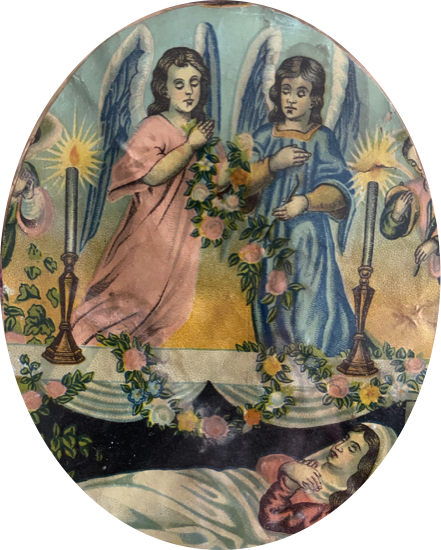
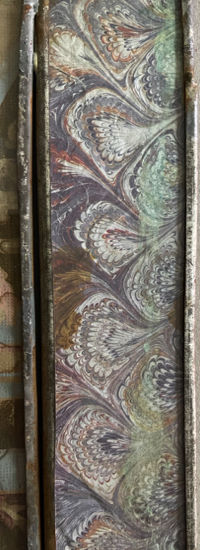

The central panel is surrounded by four other rectangular tin and reverse painted glass panels which all beautifully complement and accentuate the colors in and the composition of the central panel’s wallpaper collage and the religious chromolithograph print cut-out of The Entombment or Death of The Virgin Mary. It is a beautiful, expressive, harmonious and artistic composition and assemblage overall, perfectly characteristic and evocative of the exalted artistic sensibility and unique technical virtuosity of the work of one of New Mexico’s greatest tinsmiths, Jose Maria Apodaca (1844-1924).
Jose Maria Apodaca is generally considered to be the finest and most accomplished of all known historic New Mexico tinsmiths Apodaca’s pieces, particularly his later 1890-1910 works, are certainly among the most complex and elaborately and well-crafted New Mexico tinworks often using multiple tin, glass and wallpaper panels and elaborate scalloping, painting and other added fancy decorative touches. It would be natural for an apprentice or student or admirer tinsmith to try to imitate the master’s work in a piece of their own and this particular piece shows that decided and deliberate influence down to such obscure technical details as the square-shaped tin channels which is a specific fabrication technique that Apodaca favored.
The retablo is in generally good, somewhat rough condition and that is fairly normal considering its 130 or so years of age and the remote rugged frontier region in which it was born and spent most of its life. There are no cracks to any of the five glass panels and they do not appear to have been replaced although it is certainly possible. This is somewhat unusual for a New Mexico tinwork of this age and large size and it indicates the strong likelihood that the piece was fairly well-cared for over the years of its life and/or that it possibly hung undisturbed for a long time period in a specific religious building or family home. There is some degree of rust and staining here and there and it looks as if several of the panels might have been re-soldered on and/or replaced at some point in its life due to the presence of some brighter solder spots. Also the wire hanging loops have been re-soldered. Essentially, this is an “as-is” totally Northern New Mexico piece that has lived a rugged frontier Northern New Mexico life and shows the various scars, patches and mends it has experienced. It must be viewed through this lens and appreciated in this manner.
All in all, in our view, this tin retablo is a beautiful, rare and refined historic artwork almost miraculously created from the humblest of salvaged scrap materials by an inspired and talented anonymous New Mexico folk artist, a piece which perfectly reflects the time, place, faith and unique geographic and historic circumstances of its creation, but which also projects a completely timeless and lasting universal artistic beauty, humanity and devotional spirit.
Price $2,100 plus any applicable shipping
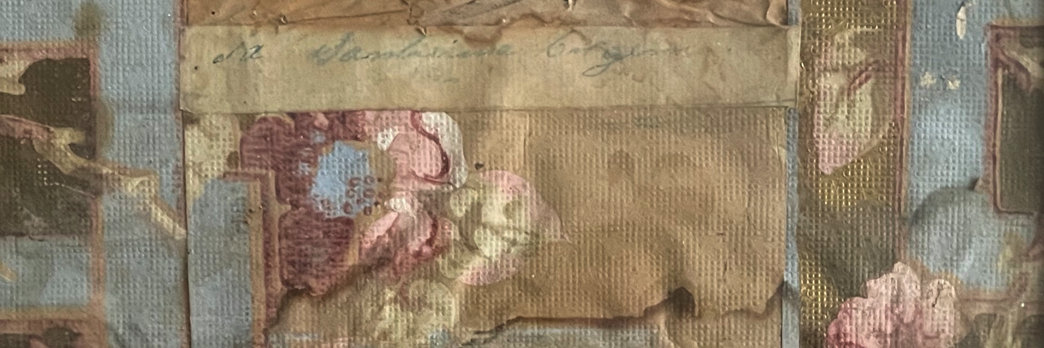
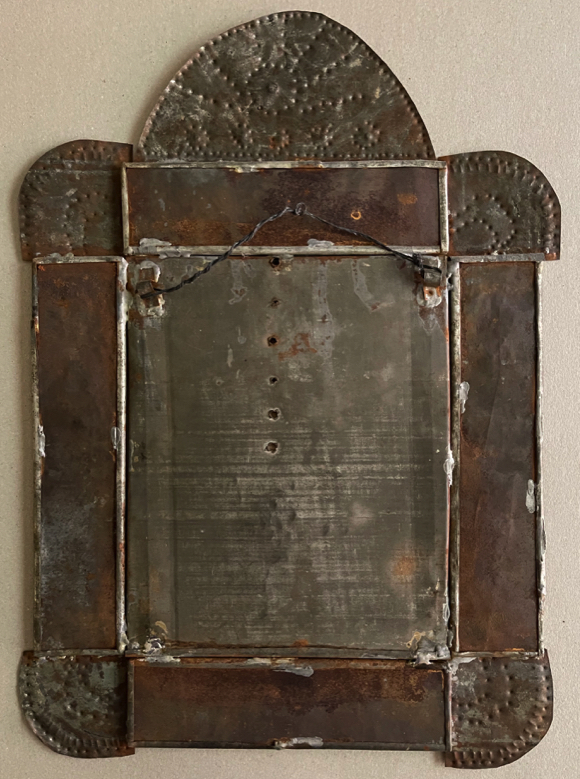


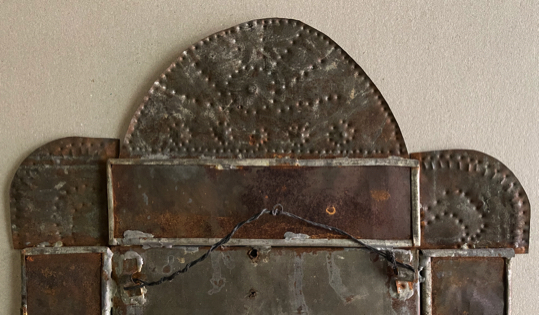
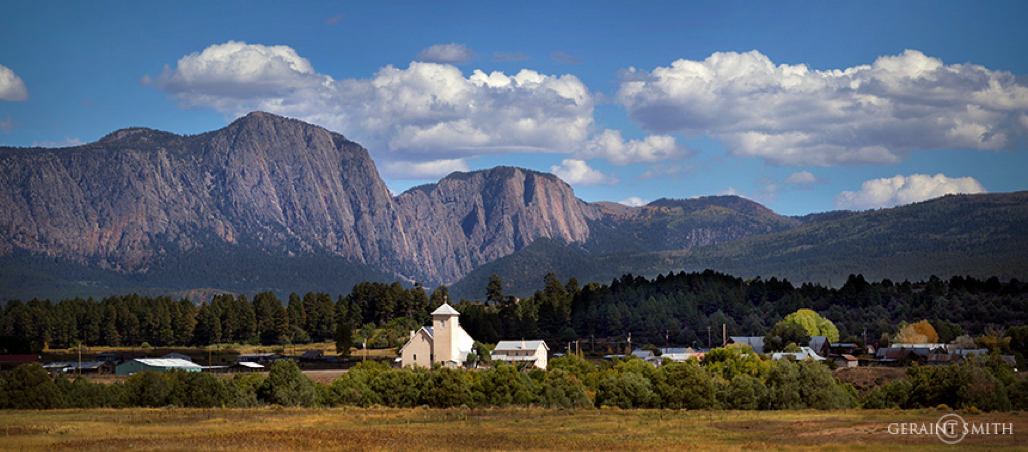
The tiny village of Los Ojos, population 125, beneath The Brazos Cliffs in Rio Arriba County, New Mexico
Photo source and © Geraint Smith Photography